New Soil Wetter and Tillage Approaches
Author: Stephen Davies, DAFWA | Date: 29 Feb 2016
Assessing options for managing water repellent gravels
Stephen Davies, Glenn McDonald, Giacomo Betti, Liam Harte, Grey Poulish, Derk Bakker, DAFWA
Richard Devlin and Rebecca Jenkinson, Living Farm
Key messages
1. On water-repellent loamy gravels (forest gravels) banded soil wetting agents and one-off deep tillage can significantly improve crop establishment, growth and grain yield
2. Strategic (one-off) deep tillage using a modified one way plough reduced topsoil water repellence and improved crop establishment and yield.
3. Strategic deep tillage provides an opportunity to incorporate lime or other soil amendments and can improve nutrient availability and uptake.
Aims
To determine which management options can successfully overcome soil water repellence and improve crop yields on water repellent sandy and loamy gravel soils.
Method
In 2015 three long-term research sites and one demonstration site were established on water repellent gravels in the West Midlands and Kojonup areas in order to assess a range of options for managing soil water repellence in a cropping system over at least 4 seasons (Table 1). The repellent gravels in the West Midlands tend to be sandier while those near Kojonup are loamier. Treatments tested included short-term mitigation options such as use of soil wetting agents or different seeding approaches and longer-term one-off (strategic) tillage amelioration options which were applied prior to seeding (Table 1). Crops were assessed for early establishment, nutrient uptake and grain yield and soils were assessed for severity of water repellence prior to the treatments being applied and after seeding.
Table 1. Summary of the soil type, soil water repellence rating using molarity of ethanol droplet (MED) test, treatments applied, growing season rainfall (GSR Apr-Oct), 2015 crop variety sown and seeding date for three sites with water repellent gravel soils established in 2015.
|
Soil Type and Site |
Soil Water Repellence (pre-seeding) |
Treatments |
GSR (mm) |
Variety and Rate |
Sowing Date |
|
|
MED |
Rating |
|||||
|
1. Sandy gravel, Moora |
3.3 |
Very Severe |
1) Control 2) One-way plough 66cm discs 3) Large 91cm offset discs 4) Modified one-way – ‘shallow’ 76cm discs 5) Modified one-way – ‘deep’ 79cm discs |
299 |
Canola 559TT, 2.5 kg/ha |
2nd June |
|
2. Sandy gravel, Badgingarra |
2.1 |
Moderate |
Main treatments 1) Control 2) Modified one-way plough 76cm discs Sub-treatments i) Knife point seeding ii) Paired row seeding iii) Wetter 1 - penetrant soil wetter iv) Wetter 2 - penetrant + absorber |
264 |
Mace Wheat, 75 kg/ha |
28th May |
|
3. Loamy (forest) gravel, Kojonup |
3.1 |
Severe |
1) Control off row 2) On-row seeding (from 2016) 3) Wetter banded on furrow – on-row 4) Wetter banded on furrow – off row 5) Wetter banded with seed 6) Blanket wetter (every 2nd year) 7) One-way ploughing 65cm discs 8) Mouldboard ploughing |
251 |
Hindmarsh Barley, 100 kg/ha |
4th May |
|
4. Loamy (forest) gravel, Kojonup (Demo site) |
3.2 |
Very Severe |
1) Control – banded wetter on furrow 2) One-way ploughing 65cm discs |
251 |
Bass Barley, 100 kg/ha |
25th May |
In the Moora and Badgingarra experiments a modified one-way disc ploughing technique was tested. In this approach every second disc is removed from a one-way disc plough allowing more space for soil to turn and larger diameter (76 cm) discs are fitted to increase the ploughs working depth (approximate depth 25 cm). At Moora two disc types were assessed on the modified one-way plough: a standard purchased disc with relatively shallow curvature (approximate dish depth 11.5 cm) and modified discs with a much greater degree of curvature (approximate dish depth 13.5 cm) intended to better invert the soil.
Results
Soil Water Repellence
The mitigation treatments on the sandy gravel at Badgingarra and loamy gravel at Kojonup did not significantly reduce the topsoil water repellence but the one-off tillage treatments had a significant impact at these sites (Fig.1A,B). At the Kojonup site (Site 3), one-way disc ploughing reduced topsoil (0-5 cm) water repellence by 43% and mouldboard ploughing completely removed it (Fig.1).
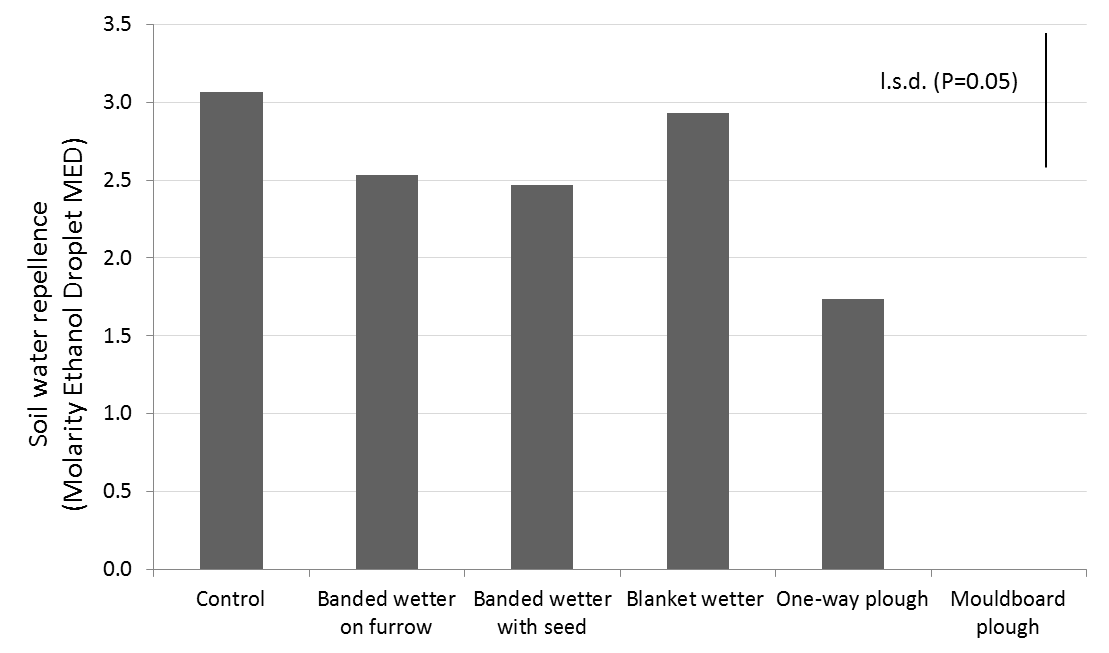
Figure 1. Impact of soil wetters and strategic tillage on topsoil water repellence (0-5 cm) of loamy gravel at Kojonup measured using the Molarity of Ethanol Droplet (MED) method.
At Badgingarra the modified one-way plough reduced the soil water repellence of the topsoil (0-5 cm) by 65% (Fig. 2), while at Moora the measured decline in water repellence due to ploughing was not significant (data not shown).
Figure 2. Impact of soil wetters and strategic tillage using a modified one-way plough on topsoil water repellence (0-5 cm) of sandy gravel at Badgingarra measured using the Molarity of Ethanol Droplet (MED) method.
Crop Establishment
At the Kojonup site establishment in the control plots was very patchy, average plant density was 68 plants/m2. Plants continued to emerge for several months following the initial germination. Where banded and blanket soil wetters were applied, plant establishment increased plant numbers to 75-77 plants/m2 an increase of 10% compared to the control. The strategic tillage options had the best early establishment with mouldboard ploughing increased plant numbers by 24% (84 plant/m2) and one-way disc ploughing by 36% to 93 plants/m2 relative to the control (Fig. 3).
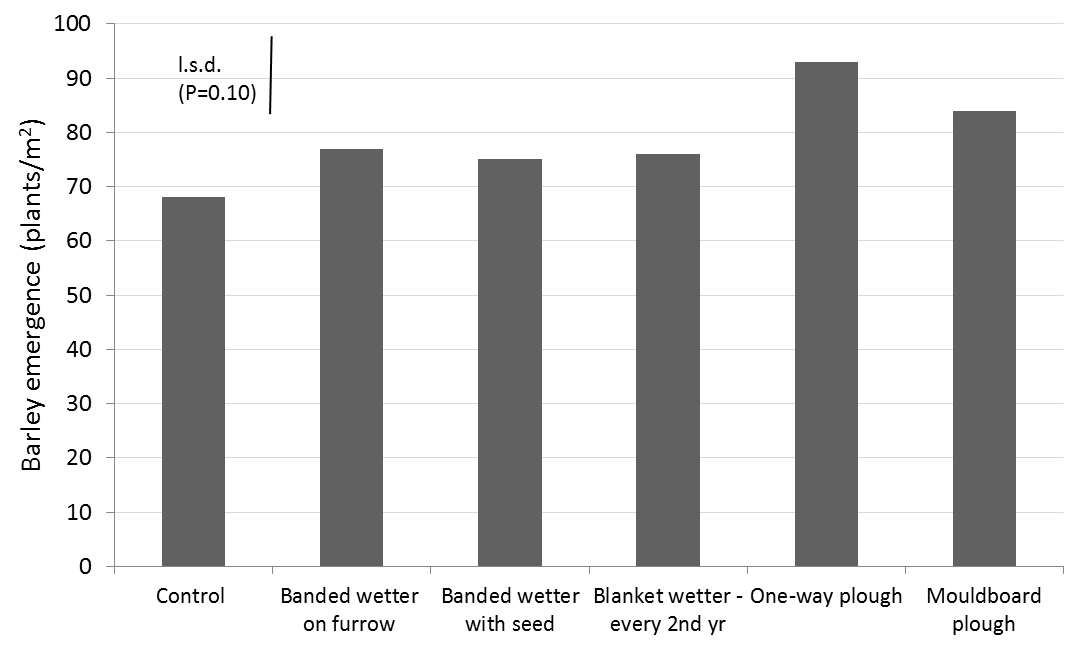
Figure 3. Impact of soil wetters and strategic tillage on crop establishment for water repellent loamy gravel at Kojonup in 2015.
At the Badgingarra site the modified one-way disc plough increased early wheat emergence by 60% or more (Fig. 4). At both sites there was trend towards increased plant numbers with the use of soil wetting agents, but these differences were not statistically significant. At Moora there was no significant difference in canola plant establishment (data not shown).
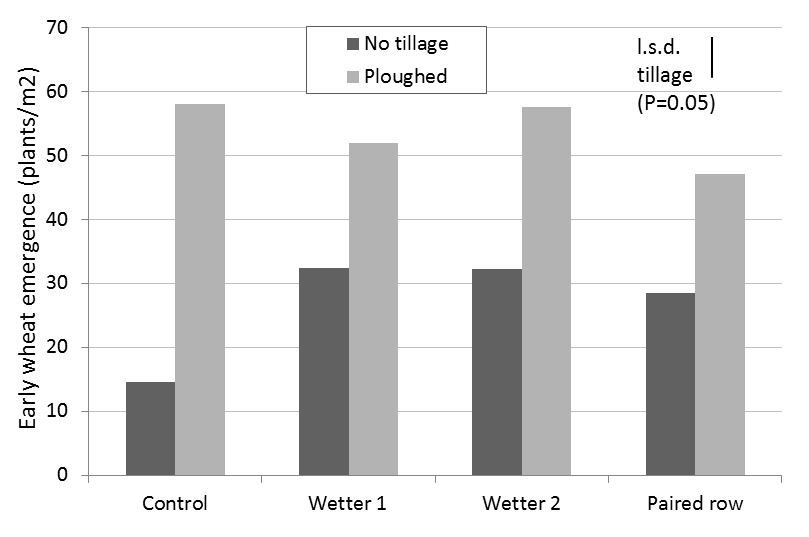
Figure 4. Impact of soil wetters and strategic tillage on crop establishment for water repellent sandy gravel at Badgingarra in 2015.
In water repellent soils crop and weed establishment is staggered and plants continue to emerge throughout the season. At Kojonup some of the apparent improvement in plant numbers with the use of soil wetters became more obvious over time, probably due to improved establishment with subsequent germinations.
Crop Grain Yield
Across all three experiments soil amelioration using strategic deep tillage had the biggest impact on grain yield. On sandy gravel at Badgingarra the mitigation options did not increase grain yield but strategic tillage with a modified one-way plough increased wheat grain yield by 1.5 t/ha, or 85% over the average yield of 1.8 t/ha for the unploughed treatments (Table 2). On average head numbers for the wheat in the ploughed soil were 17% (23 more heads/m2) and grain (kernel) weight 8% higher than for the wheat in the no-till soil (data not shown). Grain protein was also higher for the ploughed treatment at 11.1% compared to the no-till control at 10.8% (data not shown).
Table 2. Summary the change in soil water repellence and grain yield in the first seasons following strategic one-way disc ploughing of water repellent gravel soils at four sites in 2015. * Note that this control treatment for demonstration site (Site 4) included banded soil wetting agent.
|
Soil Type and Site |
2015 Crop |
In-season Soil Water Repellence (Molarity Ethanol Droplet) |
Grain Yield (t/ha) |
||||||
|
No-till |
Ploughed |
MED diff. |
l.s.d. |
No-till |
Ploughed |
Yield diff. |
l.s.d. |
||
|
1. Sandy gravel, Moora |
Canola |
2.7 |
2.9 |
- |
n.s. |
0.78 |
0.98 |
+0.20 |
0.14 |
|
2. Sandy gravel, Badgingarra |
Wheat |
1.6 |
0.4 |
-1.2 |
0.5 |
1.79 |
3.32 |
+1.53 |
0.13 |
|
3. Loamy (forest) gravel, Kojonup (North) |
Barley |
3.1 |
1.7 |
-1.4 |
0.9 |
2.75 |
4.11 |
+1.36 |
0.75 |
|
4. Loamy forest gravel, Kojonup (South, demo site) |
Barley |
3.2 |
1.0 |
-2.2 |
- |
4.33* |
5.16 |
+0.83 |
- (demo) |
At Moora the response of canola to strategic tillage was less pronounced but modified one-way ploughing with ‘shallow’ discs and use of large diameter offset discs increased grain yield by 200 kg or more (Fig. 5). The offset discs did not achieve as much inversion as the one-way discs but had a more level seed bed and more consistent early establishment.
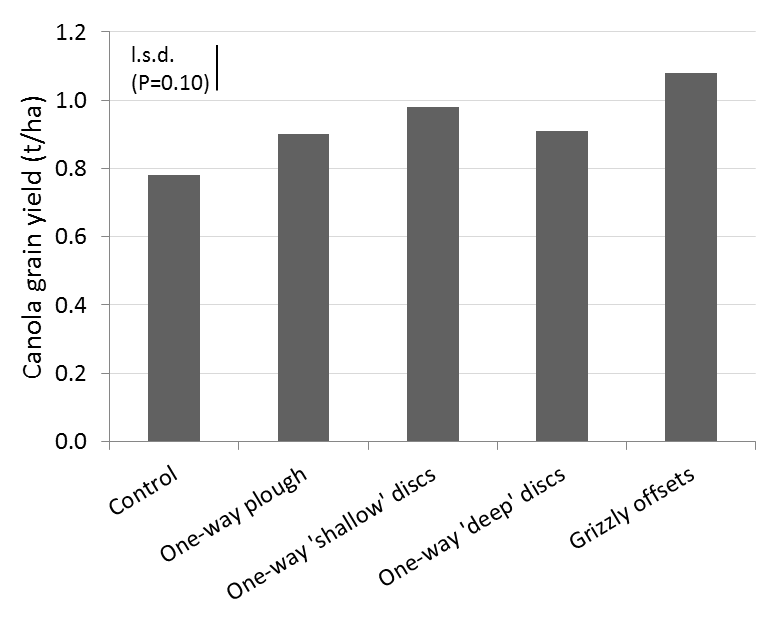
Figure 5. Impact of soil wetters and strategic tillage on canola grain yield for water repellent sand gravel at Moora in 2015.
At Kojonup both soil wetters and strategic deep tillage increased grain yield (Fig. 6). Furrow banded wetter increased grain yield by 0.72 t/ha (26%; l.s.d. 10% = 0.62) while seed banded wetter and blanket wetter increased yields by just over 1.0 t/ha (38%; Fig. 6). Responses to one-off deep tillage were even greater. One-way ploughing increased the barley yield by 1.36 t/ha (49%) and mouldboard ploughing by 1.71 t/ha (62%; Fig. 6) compared to the control. In this experiment the ploughed treatments were tested either with or without pre-emergent herbicides because in other experiments pre-emergent herbicides had caused significant crop damage, reducing yields. In this experiment there was no significant impact of pre-emergent herbicides (Fig. 6).
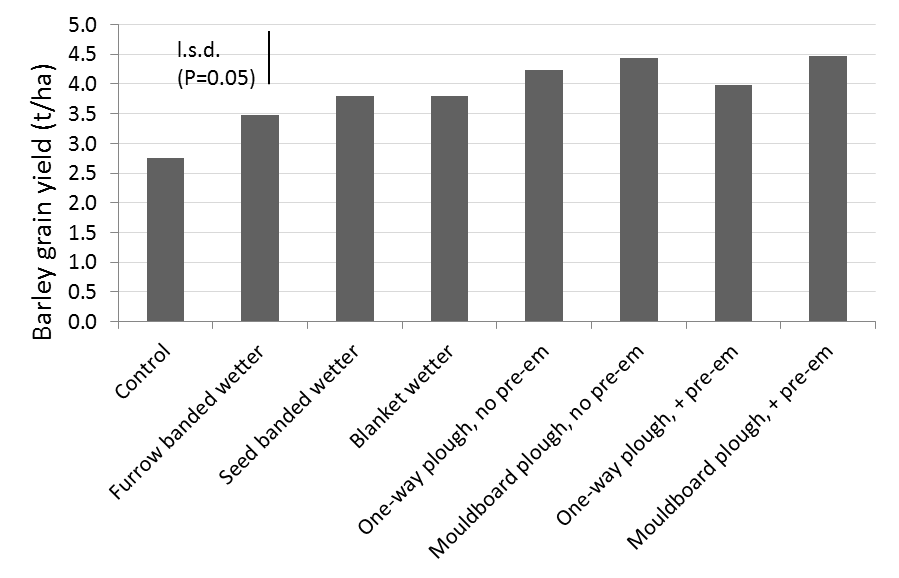
Figure 6. Impact of soil wetters and strategic tillage on barley grain yield for water repellent loamy gravel at Kojonup in 2015.
The applicability of the research trial results to growers experience is further verified by a large scale on-farm demonstration site on repellent loamy gravel near Kojonup. In this trial the entire site was seeded using banded wetter but one-off one-way ploughing increased barley grain yields by 0.83 t/ha, from 4.33 t/ha in the no-till control to 5.16 t/ha in the ploughed (Table 2).
Conclusion
In these trials one-off strategic deep tillage on repellent gravels was highly effective at improving establishment and grain yield of cereal crops. In other experiments on these soil types, soil inversion with mouldboard ploughs have given mixed results, possibly due to crop damage from pre-emergent herbicides, but this did not impact yields in these trials. On repellent loamy gravels soil wetting agents were effective in improving establishment and increasing grain yields. This result is supported by other research (Davies et. al. 2016) and grower experience. At Badgingarra soil wetters did not significantly improve establishment and yield on the sandy gravels although benefits have been measured on these soils before (Blackwell et. al. 2014). Amelioration of water repellent gravels with deep tillage is limited by rocks and cemented gravel boulders and they can leave the paddocks rough. One-way disc ploughs appear to be an effective tool for ploughing gravel soils and may be better suited to these soil types than other ploughs. One-off strategic tillage can be costly and slow to implement, so it is important to use low-cost mitigation approaches where possible to achieve benefits over all the affected soils (Blackwell et. al. 2014) while assessing the benefits of strategic tillage using test strips.
Key words
Soil water repellence; soil wetting agents; one-way ploughing; strategic tillage; gravel
References
Davies S, McDonald G, Anderson G, Harte L, Poulish G, Devlin R, Jenkinson R (2016) New opportunities for soil wetting agents on repellent soils. 2016 Grains Research Updates, , Perth WA.
Blackwell P, Hagan J, Davies S, Bakker D, Hall D, Roper M, Ward P, Mathews A (2014) Smart no-till furrow sowing to optimise whole-farm profit on non-wetting soil. 2014 Agribusiness Crop Updates, Perth WA.
Acknowledgments
Thanks to GRDC and DAFWA for funding the soil water repellence project: “Delivering enhanced agronomic strategies for improved crop performance on water repellent soils in WA’. This project is part of the GRDC’s Soil Constraints West Initiative. Thanks to SouthernDIRT and West Midlands grower groups. Particular thanks to Ben and Sean Plozza for developing and using their modified one-way disc plough in the research trials. We acknowledge and thank the host growers, their families and staff: Justin Elliott, Jono Clifton, Graham Lethlean and Erin Cahill. Thanks to Craig Scanlan for excellent reviewing of the paper.
GRDC Project Number: DAW00244
Was this page helpful?
YOUR FEEDBACK

